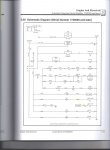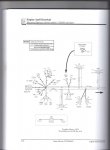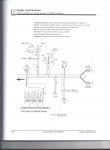Sounds like you've checked everything thus far that I would have. Getting short on ideas, working at a distance.
Sill suggest you locate wiring diagram.
Your description makes me think the 12-v sent to stop solenoid travels through it then to the starter solenoid and allows it to engage---a sequential flow of power from one device to the next designed to shut down if any one component fails. But this is just a guess at this point.
I'm now back to the 9-v you saw during 'crank' condition. Wondering if weak battery (also possibly bad chassis ground) just won't fully engage the stop solenoid and/or spin the starter enough to roll it over and fire the engine.
Also refer to your bench test. If your description is that the stop solenoid cylces in-out-in-out-in-out repeatedly while hooked up then it is bad. It should retract (or push, whichever) and hold on application of power, then release when disconnected.
My guess however is that if the stop solenoid holds one position when powered then releases when disconnected, then it would be good. Possibly back to weak battery.
Then you're back to tracing other problems. What about safety switches, perhaps a PTO or gear shift or seat switch or clutch or something similar?
Have you thought about proving a start by bypassing all the extras and jumping from battery directly to starter? CAUTION make certain out of gear.
Continue keeping us informed. Maybe an idea will pop up on the forum.
Sill suggest you locate wiring diagram.
Your description makes me think the 12-v sent to stop solenoid travels through it then to the starter solenoid and allows it to engage---a sequential flow of power from one device to the next designed to shut down if any one component fails. But this is just a guess at this point.
I'm now back to the 9-v you saw during 'crank' condition. Wondering if weak battery (also possibly bad chassis ground) just won't fully engage the stop solenoid and/or spin the starter enough to roll it over and fire the engine.
Also refer to your bench test. If your description is that the stop solenoid cylces in-out-in-out-in-out repeatedly while hooked up then it is bad. It should retract (or push, whichever) and hold on application of power, then release when disconnected.
My guess however is that if the stop solenoid holds one position when powered then releases when disconnected, then it would be good. Possibly back to weak battery.
Then you're back to tracing other problems. What about safety switches, perhaps a PTO or gear shift or seat switch or clutch or something similar?
Have you thought about proving a start by bypassing all the extras and jumping from battery directly to starter? CAUTION make certain out of gear.
Continue keeping us informed. Maybe an idea will pop up on the forum.




